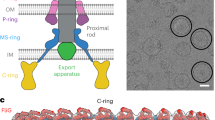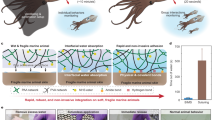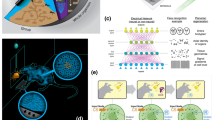Abstract
The near-surface swimming patterns of bacteria are determined by hydrodynamic interactions between the bacteria and the surface, which trap the bacteria in smooth circular trajectories that lead to inefficient surface exploration. Here, we combine experiments with a data-driven mathematical model to show that the surface exploration of a pathogenic strain of Escherichia coli results from a complex interplay between motility and transient surface adhesion events. These events allow the bacteria to break the smooth circular trajectories and regulate their transport properties by exploiting stop events that are facilitated by surface adhesion and lead to characteristic intermittent motion on surfaces. We find that the experimentally measured frequency of these stop-adhesion events coincides with the value that maximizes bacterial surface diffusivity according to our mathematical model. We discuss the applicability of our experimental and theoretical results to other bacterial strains on different surfaces. Our findings suggest that swimming bacteria use transient adhesion as a generic mechanism to regulate surface motion.
This is a preview of subscription content, access via your institution
Access options
Access Nature and 54 other Nature Portfolio journals
Get Nature+, our best-value online-access subscription
$29.99 / 30 days
cancel any time
Subscribe to this journal
Receive 12 print issues and online access
$209.00 per year
only $17.42 per issue
Buy this article
- Purchase on Springer Link
- Instant access to full article PDF
Prices may be subject to local taxes which are calculated during checkout



Similar content being viewed by others
Data availability
The data that support the plots within this paper and other findings of this study are available from the corresponding author upon request.
References
Berg, H. C. & Brown, D. A. Chemotaxis in Escherichia coli analysed by three-dimensional tracking. Nature 239, 500–504 (1972).
Berg, H. C. Random Walks in Biology (Princeton Univ. Press, 1993)..
Berg, H. C. E. coli in Motion (Springer-Verlag, 2004)..
Weis, R. M. & Koshland, D. E. Chemotaxis in Escherichia coli proceeds efficiently from different initial tumble frequencies. J. Bacteriol. 172, 1099–1105 (1990).
Schnitzer, M. J. Theory of continuum random walks and application to chemotaxis. Phys. Rev. E 48, 2553–2568 (1993).
Tindall, M. J., Gaffney, E. A., Maini, P. K. & Armitage, J. P. Theoretical insights into bacterial chemotaxis. WIREs Syst. Biol. Med. 4, 247–259 (2012).
Cates, M. Diffusive transport without detailed balance in motile bacteria: does microbiology need statistical physics? Rep. Prog. Phys. 75, 042601 (2012).
Flores, M., Shimizu, T. S., ten Wolde, P. R. & Tostevin, F. Signaling noise enhances chemotactic drift of E. coli. Phys. Rev. Lett. 109, 148101 (2012).
Zhang, H. P., Beer, A., Florin, E.-L. & Swinney, H. L. Collective motion and density fluctuations in bacterial colonies. Proc. Natl Acad. Sci. USA 107, 13626–13630 (2010).
Peruani, F. et al. Collective motion and nonequilibrium cluster formation in colonies of gliding bacteria. Phys. Rev. Lett. 108, 098102 (2012).
Ariel, G. et al. Swarming bacteria migrate by levy walk. Nat. Commun. 6, 8396 (2016).
Berke, A. P., Turner, L., Berg, H. C. & Lauga, E. Hydrodynamic attraction of swimming microorganisms by surfaces. Phys. Rev. Lett. 101, 038102 (2008).
Di Leonardo, R., DellArciprete, D., Angelani, L. & Iebba, V. Swimming with an image. Phys. Rev. Lett. 106, 038101 (2011).
Drescher, K., Dunkel, J., Cisneros, L. H., Ganguly, S. & Goldstein, R. E. Fluid dynamics and noise in bacterial cell–cell and cell–surface scattering. Proc. Natl Acad. Sci. USA 108, 10940–10945 (2011).
Spagnolie, S. E. & Lauga, E. Hydrodynamics of self-propulsion near a boundary: predictions and accuracy of far-field approximations. J. Fluid Mech. 700, 105–147 (2012).
Schaar, K., Zöttl, A. & Stark, H. Detention times of microswimmers close to surfaces: influence of hydrodynamic interactions and noise. Phys. Rev. Lett. 115, 038101 (2015).
Vigeant, M. A. & Ford, R. M. Interactions between motile Escherichia coli and glass in media with various ionic strengths, as observed with a three-dimensional-tracking microscope. Appl. Environ. Microbiol. 63, 3474 (1997).
Molaei, M., Barry, M., Stocker, R. & Sheng, J. Failed escape: solid surfaces prevent tumbling of Escherichia coli. Phys. Rev. Lett. 113, 068103 (2014).
Molaei, M. & Shen, J. Succeed escape: flow shear promotes tumbling of Escherichia coli near a solid surface. Sci. Rep. 6, 35290 (2016).
Frymier, P. D., Ford, R. M., Berg, H. C. & Cummings, P. T. Three-dimensional tracking of motile bacteria near a solid planar surface. Proc. Natl Acad. Sci. USA 92, 6195–6199 (1995).
Lauga, E., DiLuzio, W. R., Whitesides, G. M. & Stone, H. A. Swimming in circles: motion of bacteria near solid boundaries. Biophys. J. 90, 400–412 (2006).
Lauga, E. & Powers, T. R. The hydrodynamics of swimming microorganisms. Rep. Prog. Phys. 72, 096601 (2009).
Li, G., Tam, L.-K. & Tang, J. X. Amplified effect of Brownian motion in bacterial near-surface swimming. Proc. Natl Acad. Sci. USA 105, 18355–18359 (2008).
Elgeti, J., Winkler, R. G. & Gompper, G. Physics of microswimmers: single particle motion and collective behavior: a review. Rep. Prog. Phys. 78, 056601 (2015).
Hu, J., Wysocki, A., Winkler, R. G. & Gompper, G. Physical sensing of surface properties by microswimmers–directing bacterial motion via wall slip. Sci. Rep. 5, 09586 (2015).
Bianchi, S., Saglimbeni, F. & Di Leonardo, R. Holographic imaging reveals the mechanism of wall entrapment in swimming bacteria. Phys. Rev. X 7, 011010 (2017).
Clements, A., Young, J. C., Constantinou, N. & Frankel, G. Infection strategies of enteric pathogenic Escherichia coli. Gut Microbes 3, 71–87 (2012).
Pratt, L. A. & Kolter, R. Genetic analysis of microscope of Escherichia coli biofilm formation: foles of flagella, motility and type I pili. Mol. Microbiol. 30, 285–293 (1998).
Wood, T. K., González Barrios, A. F., Herzberg, M. & Lee, J. Motility influences biofilm architecture in Escherichia coli. Appl. Microbiol. Biotechnol. 72, 361–367 (2006).
Conrad, J. C. Physics of bacterial near-surface motility using flagella and type iv pili: implications for biofilm formation. Res. Microbiol. 163, 619 (2012).
Conrad, J. C. et al. Flagella and pili-mediated near-surface single-cell motility mechanisms in P. aeruginosa. Biophys. J. 100, 1608–1616 (2011).
McWilliams, B. D. & Torres, A. G. Enterohemorrahagic Escherichia coli adhesins. Microbiol. Spectrum 2, EHEC–0003 (2013).
Turner, L., Ping, L., Neubauer, M. & Berg, H. C. Visualizing flagella while tracking bacteria. Biophys. J. 111, 630–639 (2016).
Silverman, M. & Simon, M. Flagellar rotation and the mechanism of bacterial motility. Nature 249, 73–74 (1974).
van Teeffelen, S. & Löwen, H. Dynamics of a Brownian circle swimmer. Phys. Rev. E 78, 020101 (2008).
Ebbens, S., Jones, R. A. L., Ryan, A. J., Golestanian, R. & Howse, J. R. Self-assembled autonomous runners and tumblers. Phys. Rev. E 82, 015304 (2010).
Kümmel, F. et al. Circular motion of asymmetric self-propelling particles. Phys. Rev. Lett. 110, 198302 (2013).
Sauer, M. M. et al. Catch-bond mechanism of the bacterial adhesin fimh. Nat. Commun. 7, 10738 (2016).
Busscher, H. J. & van der Mei, H. C. How do bacteria know they are on a surface and regulate their response to an adhering state? PLoS Pathogens 8, e1002440 (2012).
Nord, A. L. et al. Catch bond drives stator mechanosensitivity in the bacterial flagellar motor. Proc. Natl Acad. Sci. USA 114, 12952–12957 (2017).
Adam, G. & Delbrück, M. In Structural Chemistry and Molecular Biology (eds Rich, A. & Davidson N.) 198–215 (W. H. Freeman, 1968).
Clark, D. A. & Grant, L. C. The bacterial chemotactic response reflects a compromise between transient and steady-state behavior. Proc. Natl Acad. Sci. USA 102, 9150–9155 (2005).
Vergassola, M., Villermaux, E. & Shraiman, B. I. Infotaxis as a strategy for searching without gradients. Nature 445, 406–409 (2007).
Fang, X. & Gomelsky, M. A post-translational, c-di-GMP-dependent mechanism regulating flagellar motility. Mol. Microbiol. 76, 1295–1305 (2010).
Cookson, A. L., Cooley, W. A. & Woodward, M. J. The role of type 1 and curli fimbriae of Shiga toxin-producing Escherichia coli in adherence to abiotic surfaces. Int. J. Med. Microbiol. 292, 195–205 (2002).
Nilsson, L. M., Thomas, W. E., Trintchina, E., Vogel, V. & Sokurenk, E. V. Shear-enhanced adhesion of E. coli to trimannose. J. Biol. Chem. 281, 16656 (2006).
Fletcher, M. Bacterial biofilms and biofouling. Curr. Opin. Biotechnol. 5, 302–306 (1994).
Schindelin, J. et al. Fiji: an open-source platform for biological-image analysis. Nat. Methods 9, 676–682 (2012).
Meijering, E., Dzyubachyk, O. & Smal, I. Methods for cell and particle tracking. Methods Enzymol. 504, 183–200 (2012).
Jaqaman, K. et al. Robust single-particle tracking in live-cell time-lapse sequences. Nat. Methods 5, 695–702 (2008).
Acknowledgements
We thank L. Gómez Nava, R. Großmann, A. Be’er, and G. and G. Volpe for insightful comments on the text. Experiments were performed at the C3M Imaging Core Facility (Microscopy and Imaging platform Côte d’Azur, MICA). We acknowledge support from grant ANR-15-CE30-0002-01 (project ‘BactPhys’) and from Biocodex SA (Gentilly, France).
Author information
Authors and Affiliations
Contributions
D.C. and F.P. designed the study. D.C. and R.P.-B. performed experiments. E.P.I., S.O. and F.P. performed the image and statistical analysis of the data and derived the mathematical models used to interpret the data. F.P. wrote the manuscript with the help of all authors.
Corresponding author
Ethics declarations
Competing interests
The authors declare no competing interests.
Additional information
Publisher’s note: Springer Nature remains neutral with regard to jurisdictional claims in published maps and institutional affiliations.
Supplementary information
Supplementary Information
Supplementary Figures 1–8 and Supplementary Table 1.
Supplementary Video 1
E. coli motion close to a surface, highlighting a bacterium with circular motion.
Supplementary Video 2
E. coli motion close to a surface, highlighting a bacterium with circular motion interrupted by jumps in the moving direction.
Supplementary Video 3
E. coli motion close to a surface, highlighting a bacterium with straight trajectories interrupted by jumps in the moving direction.
Supplementary Video 4
Same trajectory as in Supplementary Video 3, additionally showing the evolution of the speed of the bacterium.
Supplementary Video 5
An E. coli bacterium’s smooth motion is interrupted by a process in which the bacterium quickly rotates on a fixed spot on the glass surface. The motion resembles bacterial tethering.
Supplementary Video 6
An E. coli bacterium showing several events of adhesion with different durations. Events are labelled from A to D. A and C are short events with a duration within the timescale of the state zero. C and D show a larger duration corresponding
Rights and permissions
About this article
Cite this article
Perez Ipiña, E., Otte, S., Pontier-Bres, R. et al. Bacteria display optimal transport near surfaces. Nat. Phys. 15, 610–615 (2019). https://doi.org/10.1038/s41567-019-0460-5
Received:
Accepted:
Published:
Issue Date:
DOI: https://doi.org/10.1038/s41567-019-0460-5
This article is cited by
-
Facilitating nitrification and biofilm formation of Vibrio sp. by N-acyl-homoserine lactones in high salinity environment
Bioprocess and Biosystems Engineering (2024)
-
Geometric constraint-triggered collagen expression mediates bacterial-host adhesion
Nature Communications (2023)
-
The accumulation and growth of Pseudomonas aeruginosa on surfaces is modulated by surface mechanics via cyclic-di-GMP signaling
npj Biofilms and Microbiomes (2023)
-
Hydrodynamic tearing of bacteria on nanotips for sustainable water disinfection
Nature Communications (2023)
-
Active matter in space
npj Microgravity (2022)



